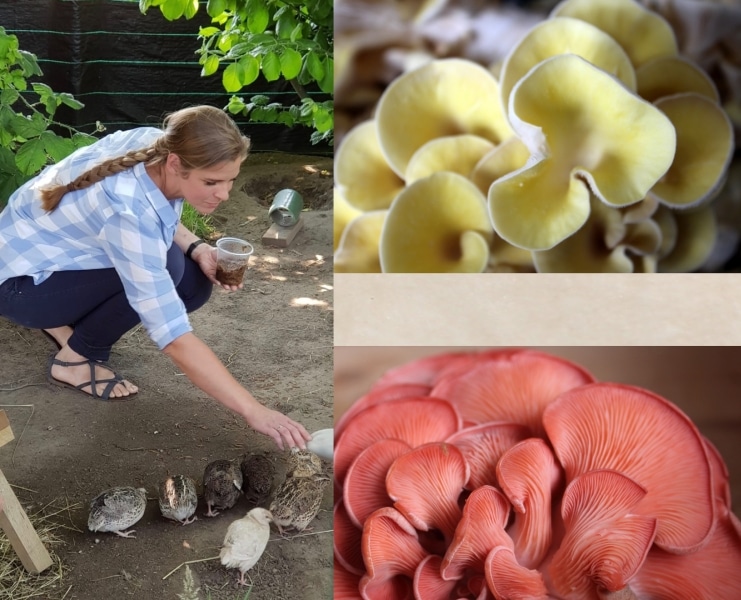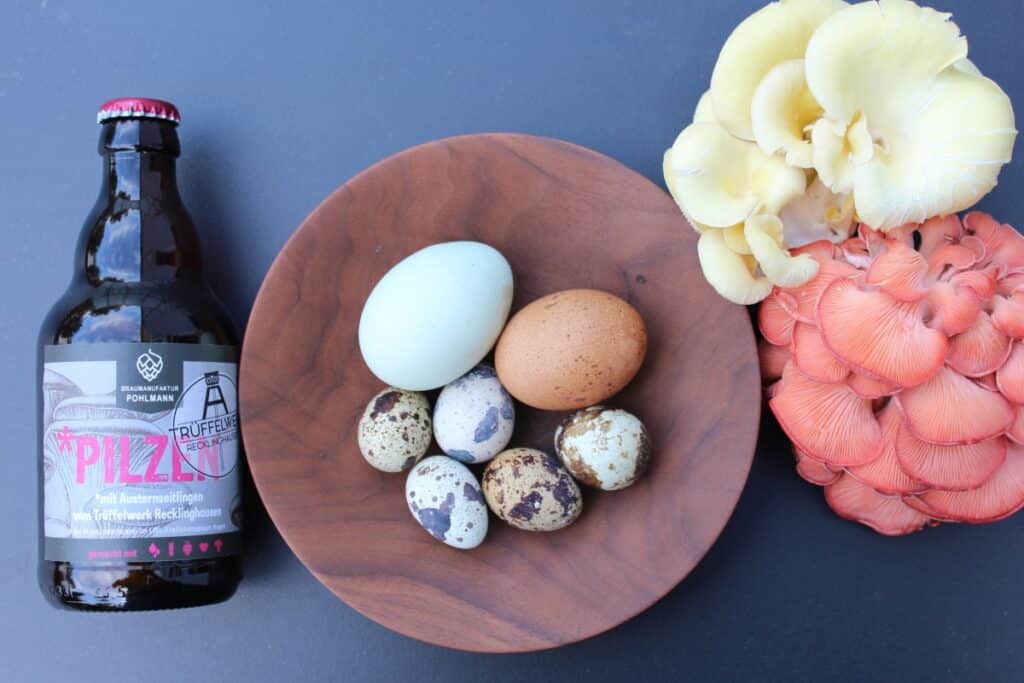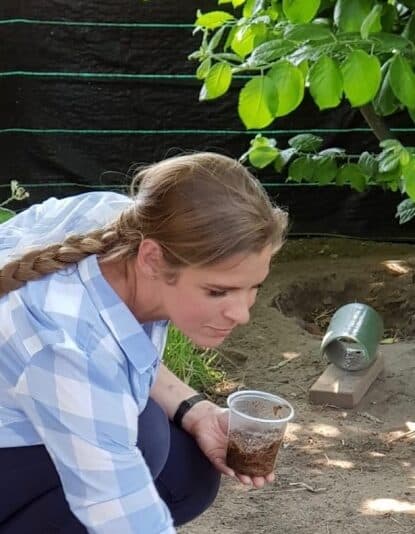
Mushrooms – in amazing colors!
How does a young woman get into farming mushrooms?
Sarah’s love for nature and her goal to treat natural resources with care leads her into 'exploring' a special food: the oyster mushroom and the 'Burgundy' truffle. In 2016 she establishes her company 'Trüffelwerk' (Truffle plant). Quite a fancy name as her farm is situated in the former coal mining area of Germany with a lot of old industrial sites around.
Which natural product suits me with my initial situation?
That is the question that gets everything rolling. Sarah owns a small former nursery site and a successful start in the 'Human Resources' department of a large company. She completes her master’s in educational science together with the birth of her second child. Her first business experience got her thinking about the compatibility of family and career.
"As an academic, I was faced with a career in a large corporation, but also a 40-hour week away from my family. Now I have a 60-hour week, but my children can see and talk to me at any time. I can always be there for them in between all my business activities. But that also means giving a cooking event in the evening or selling my products at a market stall on the weekend."
The mushroom farm idea: strategic steps & business plan
The idea of reconciling family and work leads her to an appointment with a competent employee of the Ministry of Agriculture. With this advice, she develops a business plan for mushroom cultivation. The halls on the premises are already a good starting point for the cultivation. But first she reads a lot about different mushrooms. As an academic she knows how to ‘digest’ technical and scientific literature. She spends many hours in her small self-built laboratory - experimenting with different fungal spores, the growth media such as rye, straw pellets as the culture media, humidity, and other necessary factors. The old concrete mixer is simply used to mix her new nutrient substrate. Then she puts her mixture in old plastic containers. The fungi spores start to grow. Within 2 days you can see the small mushroom shapes and the colors emerge: fascinating shades of lemon-yellow, pink-orange and cream-beige pop up.
The colors of her fungi go along with a unique taste. The Golden oyster mushroom has a slight lemon taste, the Pink oyster mushroom has a touch of bacon and the texture of the Pearl oyster mushroom is a bit like chicken meat. But first of all Sarah deals with the financial side of starting a business.
"The lead time of 2 years until the first harvest was first without earnings. I also had to work on the ‘marketing and sales’ points in my business plan and to make a decision about my start-up concept. That took much blood, sweat and tears."
Next steps and farm store project
Sarah gains a lot of experience in the first few years which makes her an expert now on her mushrooms. No detail on the mushroom cluster escapes her critical eye. She constantly checks the parameters: Is the humidity set correctly? How does the mushroom react to the new growing medium? Many factors change the perfect and healthy look of her oyster mushroom. Sarah knows all the facts to grow a great natural product. She researches further for a suitable organic supplier to deliver pre packed culture grounds. She needs to be more efficient to cope with the growing demand for her products.
Which products are a great addition to my oyster mushrooms?
Sarah starts growing quails and different chicken. Their special egg colors are a great addition to her Golden and Pink oyster mushrooms. Then she has the idea of using her a mushrooms to brew a beer. This is now produced by a master brewer and sold in her farm shop. What to do with her non sold fungi? Pragmatic as she is she starts drying her left over mushrooms in her farm shop. She uses the dried product for her special risotto mixture, which she produces herself in a friend's gastro kitchen. Her ‘no waste’ strategy is a great motivator for her to develop more food ideas.

Slow Food and Slow Investment
Even as Sarah experiments with growing her oyster mushroom, she is investing in another mushroom that she may not be able to harvest for another 10- 15 years. She is planting thirty different deciduous trees, still very small. Their root systems are 'inoculated' with the Burgundy truffle fungal web. Before planting, she does a lot of research, as always. At a French truffle institute, she has her soil tested and finds the appropriate natural additives. That is needed so that the fungus spores have a chance to multiply and to slowly grow. Now you understand why she choose the name ‘Truffle plant’ for her business.
"I find this special symbiosis of tree, fungus and nature absolutely fascinating. The seedling must grow very slowly so that the burgundy truffle has a chance to develop. The tree bark slice with the hardwood shredded around the trunk keeps the area free of other plants. And my oldest son keeps the meadow clear. He is responsible for mowing the lawn and doing other small chores. Even at 12 years old, children can gain a lot of confidence from their little chores. We as parents just have to trust them that they can do it."
Sweden - favorite country and ‘haven of peace’
Yes, also Sarah needs a retreat to recharge and just be in nature without doing anything with nature. She already starts to relax driving to southern Lapland - the journey is the reward. You can see her fondness for this land in some of the details on her property. The ‘Swedish flower’ chicken belongs to her small but fine chicken gang.
"We spend the summer vacations in Sweden on an old farm. This fits perfectly with my mushroom growing business. During this time, I turn off the moisture in the growing rooms and stop production beforehand. This allows the shelfs and rooms to dry out well and I can avoid a nasty mold infestation of the walls and the hall."
Do chicken have a favorite dish?
Leave it up to Sarah to tell you about her chicken behavior. Her interest in nature can be noticed in many various facets like the attention to her chicken ‘talking’.
"I have fun observing my chickens. I now recognize 30 different sounds of their chicken language. My rooster not only protects the hens, but he is also sometimes the arbitrator of a dispute. I noticed that my chickens like to eat pasta leftovers. Well, now of course when I cook pasta for my family I always cook a second pot of pasta for them. My chickens are also much more intelligent than my quails, but please don’t tell them.”
What are your goals for the future?
Sarah certainly has more than just 10 goals. She loves the challenge and just trying out something new. There is always a space for additional projects in her business plan. The children will eventually grow up and become more independent and can go their small but own ways. But for now, Sarah is preoccupied with this consideration:
"What's currently at hand is the decision - Do I want to grow my business? There are enough inquiries from larger customers like bigger local supermarkets. I do have enough space here. Then I would be even more involved with the organizational part of the business. Spontaneously trying something out or pursuing a somewhat crazy idea - that might become a challenge. I would have to hire more people. It is a perfect fit with the three women I have employed now. They are all mothers and we support each other if a child is sick or any other issues like this. Will that still work if I have more employees doing the ‘day to day’ work?"
So, the question of whether to set up a show kitchen in her barns is pretty simple as Sarah is very practical. If she has everything on site like doing her cooking classes, processing her mushroom mixtures and other products, then she has more time. To do what? Well she likes to spend more time working in her organic garden on side. Another project that fits her ‘mother & businesswoman’ strategy. Her children can learn a lot about nature while being with their mother and helping her.
As a 'multitasking capable' woman, Sarah will surely tackle many more exciting projects. I'll be happy to stop by again.

Name: Sarah Küper
She is:
farmer, has a MA in Educational Science, hunter & mother with 4 kids
To be found:
in Recklinghausen, Ruhr Area, North Rhine-Westphalia, Germany - this was the biggest coal mining area in Germany
She sells her products in her own farm shop or at local market stalls
She likes:
Walking with truffle and hunting dog Otto, gardening, going hunting, biking, playing the piano, reading historical novels and reading in general.
She admires:
'My great-grandmother, who ran a farm with 10 children and was said to be incredibly quiet and loving.'
Her WIASOLA tip:
Here 5 favorite songs:
- Claude Debussy ‚Clair de Lune‘
- Type O Negative ‚Green Man‘
- Edvard Grieg ‚Solveigs Song‘
- Beatles ‚Here comes the sun‘
- George Gershwin ‚Summertime‘
To be found under:
- Food facts - did you know that...?
- Color inspire also while preparing a meal
Click here for more WIASOLA pages about mushrooms.
Food Facts - did you actually know ...?
Color can inspire while preparing a meal
Click here for more WIASOLA pages with mushrooms.